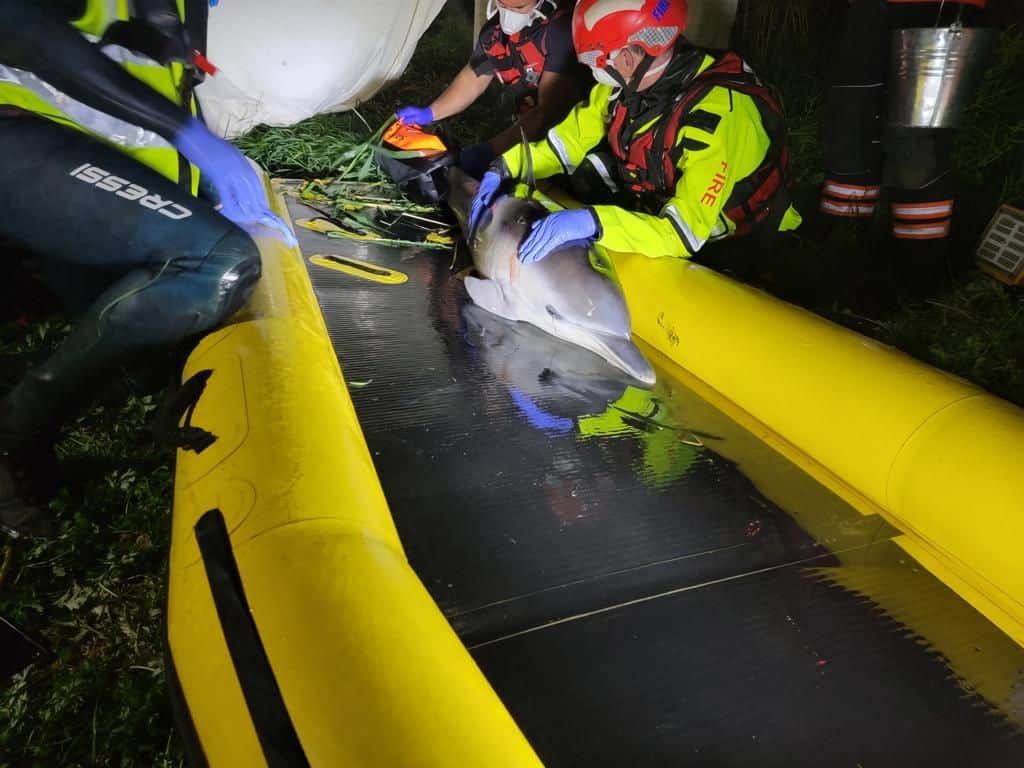
***UPDATE***
On Monday 4 September the second dolphin was confirmed to have died. The adult female common dolphin exhibited no sign of trauma consistent with stranding as the younger animal did.
The Cetacean Stranding Investigation Programme (CSIP) also confirmed the smaller dolphin found on Saturday was probably not maternally dependent, although likely to have been socially dependent.
***
BDMLR Medics responded to a common dolphin trapped in reeds at the edge of the New Bedford River near Pymoor which runs off the River Great Ouse in Cambridgeshire at 7.30pm on Saturday 2 September. The young dolphin was thought to be one of a pair seen as far inland as Bluntisham over the last few days, around 45 miles from open water.
BDMLR Medics assessed the scene upon arrival and understanding the complications of a rescue of this nature, called upon the Cambridgeshire Fire & Rescue Service for support and additional help and equipment. The dolphin had wedged itself deep into the reeds, which have thick hollow stems and can grow to 5 meters high, making the task of extracting the dolphin even more difficult.
With the reeds cut back and the dolphin now out of the water and on our dolphin rescue raft, a full assessment was carried out and first aid measures applied to the stressed animal. There was some minor visible trauma to the dolphin’s dorsal area and its breathing rate was elevated. The young dolphin was almost certainly maternally dependent and would need to be able to find its mother if it were to have a chance of survival, but with no sightings of an adult in that area of the river, it was looking more likely that they had become separated before the calf stranded.
With the uncertainty of whether the mother was in the river and just out of human sight and hearing, and with the dolphin’s breathing returning to normal parameters, the decision was made to refloat the dolphin in the river, and observe for as long as possible in the low light in case it were to restrand. The dolphin initially started to swim down river but quickly stopped and was carried back by the flow of the river to where it had started, the dolphin’s course was corrected but again it made little effort to swim and was just being carried back to the river bank and reeds.
With the Fire & Rescue service still on scene providing support, a veterinarian was called out and the dolphin was euthanized on welfare grounds at around 1am. The Cetacean Stranding Investigation Programme and they will carry out a post mortem examination which will give us an insight into the health of the dolphin calf, and determine how long it has been in the river.
We are still looking out for the other dolphin to track its movements and monitor its health. If she can find her way back out to sea without intervention that would be the preferred outcome, however we are considering other options if we have further cause for concern over welfare. In the meantime members of the public are reminded that this species is protected by law from disturbance and should not be approached or interfered with in any way by water users as this may cause distress and difficulties with her current situation.
We would like to thank Cambridgeshire Fire and Rescue service for their unwavering support throughout the incident, and to BDMLR Medics James Bryan, Abs Ginimav and to Becky Carter for a long unplanned night on the river.
Photo credit: Abs Ginimav
